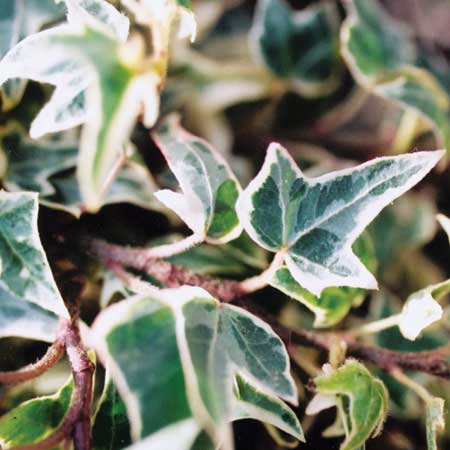|
Ivy of the Year 2001
Hedera helix 'Lady Frances'

Photo Rachel Cobb
After a three-year selection period The American Ivy Society has selected Hedera helix 'Lady Frances' as the first "Ivy of the Year."
The "Ivy of the Year" is a new national program presented by The American Ivy Society and it is to be an annual event. The "Ivy of the Year" is selected for its attractiveness, ease-of-growth, and multi-purpose uses. In addition, the ivy must be suitable for both interior use as well as exterior home landscaping. The ivy is chosen by ratings from members of The American Ivy Society, nurserymen and growers across the United States. The nominees come from the AIS test gardens and the commercial testing programs.
'Lady Frances' fulfills all the requirements for winning this honor.
'Lady Frances' is a miniature ivy that has small, variegated leaves that are star-like but highly asymmetrical, about one inch long and nearly as wide. It makes a beautiful hanging basket because it is strongly self-branching, and the lateral runners turn upward as the vines get longer. It is very desirable for use in topiary, especially where a fine-textured gray-and-white contrast is needed. In the garden 'Lady Frances' is hardy, non-invasive, and produces bushy mats of foliage. It makes an excellent contrast in shady gardens to green Hostas, Astilbes and Impatiens. 'Lady Frances' has been grown outdoors in the harsh winter conditions of central Ohio (USDA Zone 5) since 1993.
The variegation of 'Lady Frances' is gray and white. The central leaf areas are haphazardly splashed with various shades of gray that are sometimes overlaid with a deeper gray-green. The conspicuous white border is wider in some areas than others.
'Lady Frances' was discovered by Mo Halawi, Director of Operations and Landscape Design at Weidners' Gardens in Encinitas, California. It was found in the greenhouse as a sport of the typical phase of the widely-grown ivy, 'Schaefer Three' (also incorrectly called 'Kolibri'). Because Halawi wished to honor Frances Rynearson, American Ivy Society member in San Diego who introduced him to the world of ivy and topiary, he named the ivy, 'Frances'. The name was modified to 'Lady Frances' both to denote this charming little ivy's elegance, and to further honor Frances Rynearson.
"Ivy of the Year"
Because of the surge in popularity of ivy as a pot plant as well as in the garden, The American Ivy Society announced it will select an "Ivy of the Year" annually commencing in 2001. The ivy chosen from the nominees must be easy to grow, hardy, lush, beautiful, and not invasive in the garden.
The "Ivy of the Year" will be chosen by a committee made up of members of The American Ivy Society, nurseryman and growers across the United States. Each ivy will have completed the three year trial period in The American Ivy Society test gardens as well as in commercial nurseries.
When The American Ivy Society was founded in 1974 there were approximately 60 different cultivars of Hedera (Ivy) grown commercially. Today there are over 480 named cultivars. The intense interest in ivy began when people learned that the new ivies are available in an array of colors ranging from all shades of green, green and white to yellows and golds - and they are not invasive as were many of the older cultivars. Some ivy leaves are so delicately cut they resemble the print a bird's foot makes in the sand, while others are curly or fan shaped. They are used as groundcovers, garden specimens, hanging baskets, mixed containers, topiary and the adult forms of ivy are even grown as shrubs.

|